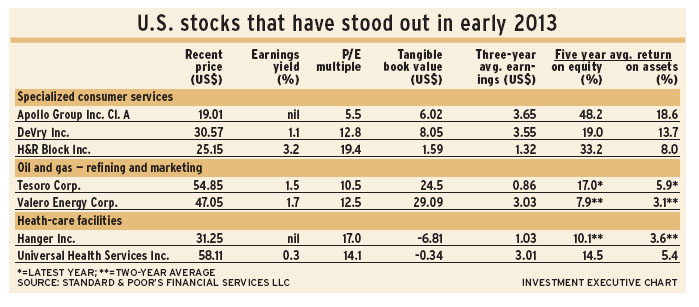
Corporate earnings in the U.S. will rise strongly again next year, analysts say. But how likely is it that this will happen?
The consensus from analysts estimates earnings on the Dow Jones industrial average (DJIA) will rise by 8% in 2013. On an individual DJIA stock basis, the consensus is an average 14% rise in 2013 vs the expected 19% gain in 2012.
A report from Standard & Poor’s Financial Services LLC (S&P) says the consensus estimate for the S&P 500 composite index’s operating earnings next year is US$115.14. This would be up by 13% from the expected US$101.51 earnings in calendar 2012. The 2012 earnings on the index are expected to be 5% higher than 2011 earnings. (All of these estimated gains are well above earnings growth rates since 2000.)
This is particularly relevant because the U.S. is only two months away from a “fiscal cliff.” On Jan. 1, tax rates are expected to rise sharply and government spending is expected drop. The U.S. presidential election result could smooth out the drop – or, perhaps, just defer it.
The U.S. stock market’s bullish trend implies it has discounted any big problem in the near term. The S&P 500, the bellwether for the U.S. market, has risen by 14% year-to-date and by 17% over the past 12 months. However, the stock market has two months in which to change its mind.
Unless Congress makes some quick changes in its lame-duck session after the election, tax rates affecting investors will rise sharply. For example, dividends will be taxed as ordinary income, leading to a jump as high as 44% from 15%. The long-term capital gains tax will rise to 20% from 15%. There also will be a new 3.8% tax on investment income.
Among the analysts who doubt U.S. business growth in 2013 are those at the International Monetary Fund. They expect the fiscal cliff to cut the U.S. economic growth rate by four percentage points, pushing the country into recession again.
Securities analysts foresee the strongest earnings growth in 2013 will be in telecommunications services and materials, according to the S&P report. For telecoms, the consensus is a 21% rise in 2013, vs an 8% gain in 2012. The consensus is 26% growth in materials earnings, compared with an expected 5% drop in 2012. But these are two of the smallest sectors of the U.S. market, at 3% each.
The largest sector, information technology (with a 20% weighting in the S&P 500), ranks third in growth expectations. The consensus is an 18% rise in 2013, after a 12% gain in 2012.
Energy ranks as weakest sector in expected earnings growth, at 7% in 2013. In contrast, calendar 2012 earnings for this sector will drop by 4%, according to the S&P report.
There is an alternative way to gauge potential earnings. A useful check on analysts’ estimates is the long-term trend measured by statistical analysis – either least-squares or exponential.
Measuring S&P 500 earnings since 2000, the curving exponential trend line projects 2013 operating earnings will be US$97.60, 15% below the analysts’ consensus. The straight-line least-squares trend line projects US$95.50 earnings, 17% less than the consensus.
Over the 10-year period of 2003-12, S&P 500’s earnings grew at an average annual rate of 8.6%.
According to value-investing guru Benjamin Graham’s favoured method of calculating the growth rate using the average earnings in the first three years and the average of the last three years in a 10-year period, the S&P earnings growth rate is 6.9%.
These estimates are on operating earnings, which generally are higher than reported corporate earnings, partly because they exclude extraordinary items.
Much of recent earnings growth has been the result of corporate cost-cutting. Thus, some analysts now focus on sales growth. Current data suggest caution because the S&P 500’s price/sales ratio has climbed to more than five times, vs 3.6 times at the market’s 2009 low and eight times at the bull market’s height in 2000.
Compared with book value, the market’s price level appears moderate. The S&P 500 currently is just above twice book value, compared with 1.8 times at the 2009 low and five times book value at the 2000 market peak.
© 2012 Investment Executive. All rights reserved.